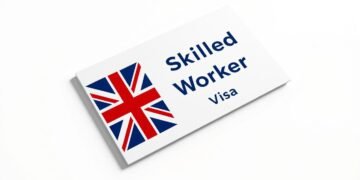Have you ever wondered how skilled workers navigate the process of moving to a new country? The immigration system for skilled professionals is designed to attract top talent, and understanding its mechanics is crucial for success. One of the most popular pathways is the Express Entry system, which uses a points-based CRS score to evaluate candidates.
This system includes three federal programs: the Federal Skilled Worker Program, the Canadian Experience Class, and the Federal Skilled Trades Program. Each program has specific requirements, but all rely on the CRS score to rank applicants. Knowing how to maximize your points can make all the difference in your application.
From language tests to educational assessments, the process involves several steps. This guide will walk you through everything you need to know, from eligibility criteria to the final application. Let’s dive in and explore how you can achieve your dream of starting a new chapter in your life.
Key Takeaways
- Understand the basics of the Express Entry system for skilled workers.
- Learn how the CRS score works and its importance in the process.
- Explore the three federal programs: FSWP, CEC, and FSTP.
- Discover essential documents required for a successful application.
- Get updated information on category-based draws and policy changes.
- Follow a step-by-step guide from profile creation to PR application.
- Find strategic tips to maximize your CRS points and avoid common errors.
Introduction to Canada Express Entry

Are you exploring pathways to move to a new country as a skilled professional? The Express Entry system is a digital platform designed to manage applications for three federal economic immigration programs. Launched in January 2015, it replaced the outdated paper-based system, offering a faster and more efficient process.
This system ranks candidates using the Comprehensive Ranking System (CRS), ensuring a competitive and fair selection process. One of its key advantages is the average processing time of six months or less for 80% of applications. This is a significant improvement over traditional immigration routes, which often took 12 to 24 months.
What is Canada Express Entry?
The Express Entry system handles applications for the Federal Skilled Worker Program, the Canadian Experience Class, and the Federal Skilled Trades Program. It evaluates candidates based on factors like age, education, work experience, and language proficiency. This ensures that only the most qualified individuals are invited to apply for permanent residence.
Why Choose Express Entry for Canadian Immigration?
Choosing this system offers several benefits. Its digital nature reduces paperwork and speeds up processing. Temporary residents can also transition to permanent residence under dual intent considerations. Recent updates, such as category-based STEM draws in 2025, make it even more attractive for skilled professionals.
Understanding the Express Entry System

The journey to permanent residency involves a structured and competitive system. The express entry system is designed to streamline applications for skilled professionals. It operates through a four-stage process: eligibility check, profile creation, CRS ranking, and ITA issuance.
First, candidates must meet the eligibility criteria for one of the federal programs. Once confirmed, they create a profile in the express entry pool. Profiles are ranked using the Comprehensive Ranking System (CRS), which evaluates factors like age, education, and language proficiency.
How Does Express Entry Work?
The system uses a points-based approach to rank candidates. Core human capital factors, such as work experience and education, are weighted heavily. Additional points can be earned through provincial nominations or a valid job offer.
Every two weeks, the system conducts draws to invite top-ranking candidates to apply for permanent residency. Tie-breaker rules are applied when multiple candidates have identical CRS scores. Profiles remain active for 12 months, allowing candidates to improve their scores if needed.
Key Components of the Express Entry System
Understanding the CRS is crucial for success. It breaks down into core human capital points and additional points. Core points are based on age, education, work experience, and language skills. Additional points come from factors like a provincial nomination or a sibling living in the country.
Recent updates in 2025 have removed job offer points, except for FSWP eligibility. This change emphasizes the importance of human capital and adaptability. Staying informed about these updates can give candidates a competitive edge.
Eligibility for Canada Express Entry
Understanding the eligibility requirements is the first step toward securing permanent residency. Each program under the skilled worker immigration system has specific criteria tailored to different professional backgrounds. Meeting these standards is essential for a successful application.
Federal Skilled Worker Program
The federal skilled worker program is designed for professionals with significant work experience. Applicants must score at least 67 out of 100 points based on six selection factors. These include age, education, work experience, language proficiency, arranged employment, and adaptability.
Language proficiency is a critical component, requiring a minimum of CLB 7 in English or French. Educational credentials must also be assessed to ensure they meet Canadian standards. Additionally, applicants must demonstrate sufficient settlement funds to support themselves and their families.
Canadian Experience Class
The canadian experience class is ideal for individuals with at least one year of work experience in the country. This program aligns with the National Occupational Classification (NOC) system, ensuring that applicants have relevant skills.
Language proficiency remains a key requirement, with a minimum of CLB 7 for most applicants. Unlike other programs, the CEC does not require applicants to prove settlement funds if they are already working in the country.
Federal Skilled Trades Program
The federal skilled trades program caters to tradespersons with a valid certificate of qualification or Red Seal endorsement. This program requires a lower language benchmark of CLB 5, making it accessible to a broader range of applicants.
Applicants must also demonstrate relevant work experience in a skilled trade. Like other programs, they must meet settlement fund requirements unless they are already employed in the country.
Inadmissibility due to medical or criminal issues can affect eligibility across all programs. Staying informed about these requirements ensures a smoother application process.
Comprehensive Ranking System (CRS)
The Comprehensive Ranking System (CRS) is a critical factor in determining your eligibility for skilled immigration. This 1,200-point system evaluates candidates based on core human capital factors and additional adaptability criteria. Understanding how it works can significantly improve your chances of success.
What is the CRS Score?
The crs score ranks candidates in the immigration pool. Core factors include age, education, work experience, and language proficiency. For example, candidates aged 20-29 receive the maximum points for age, while higher education levels can add up to 140 points.
Language skills are another crucial component. Proficiency in English or French can earn up to 160 points. Bilingual candidates receive additional bonus points, making language proficiency a key area to focus on.
Factors Affecting Your CRS Score
Several elements influence your crs score. Education equivalency assessments ensure foreign credentials meet local standards. Work experience, especially in STEM fields, can also boost your ranking. Recent updates in 2025 emphasize the importance of French proficiency for category-based draws.
Having a sibling in the country or previous canadian experience can add bonus points. Provincial nominations provide a significant 600-point boost, making them a strategic advantage. Spousal factors, such as their education and language skills, also impact the overall calculation.
Strategic planning is essential. Focus on improving your language proficiency, gaining relevant work experience, and exploring provincial nomination options. These steps can help you maximize your crs score and increase your chances of receiving an invitation to apply.
Documents Required for Express Entry
Gathering the right paperwork is a crucial step in your immigration journey. Submitting accurate and complete required documents ensures your application is processed smoothly. Missing or incorrect documents can lead to delays or even rejection.
Essential Documents for Your Application
Your document checklist starts with language test results. Approved tests include IELTS or CELPIP for English and TEF for French. These results are mandatory and must meet the minimum language proficiency requirements.
Educational credential assessments (ECA) are also essential. Organizations like WES or IQAS evaluate your foreign education to ensure it meets local standards. This step is critical for maximizing your CRS score.
Proof of funds is another key requirement. For 2024, single applicants must show $15,263, while couples need $19,001. This ensures you can support yourself and your family upon arrival.
How to Prepare Your Documents
Start by gathering all necessary documents early. Police certificates are required for every country you’ve lived in for more than six months. These must be recent and valid at the time of submission.
Medical exams are another important step. They must be conducted by a panel physician approved by the immigration authorities. Ensure your exam results are valid throughout the application process.
All documents not in English or French must be translated by a certified translator. Digital submissions must follow specific formatting and size limits to avoid technical issues.
By preparing your documents carefully, you can avoid common mistakes and ensure a successful application. Double-check every item on the checklist to stay on track.
Step-by-Step Guide to Applying for Express Entry
Navigating the skilled immigration process can seem overwhelming, but breaking it into steps makes it manageable. This guide walks you through each stage, from determining eligibility to submitting your application for permanent resident status. Follow these steps to ensure a smooth and successful journey.
Step 1: Determine Your Eligibility
Start by using the IRCC’s Come to Canada tool. This online assessment helps you confirm if you meet the basic requirements for skilled immigration. It evaluates factors like age, education, work experience, and language proficiency. Completing this step ensures you’re on the right track before proceeding.
Step 2: Create Your Express Entry Profile
Once eligible, create your profile in the immigration pool. Include accurate details about your education, work history, and language test results. Optimize your profile by highlighting key strengths, such as advanced degrees or bilingual skills. A well-crafted profile increases your chances of ranking higher in the system.
Step 3: Improve Your CRS Score
Your Comprehensive Ranking System (CRS) score determines your ranking in the pool. Focus on areas like language proficiency, additional education, or gaining a provincial nomination. Even small improvements can significantly boost your score and enhance your chances of receiving an ITA.
Step 4: Receive an Invitation to Apply (ITA)
If your CRS score is high enough, you’ll receive an ITA. This invitation allows you to apply for permanent resident status. You have 60 days to submit your complete application, so start preparing your documents immediately.
Step 5: Submit Your Application for Permanent Residence
After receiving your ITA, gather all required documents, including proof of funds, medical exams, and police certificates. Pay the application fees, which include a $1,525 base fee and a $575 Right of Permanent Residence Fee (RPRF). Don’t forget to complete biometrics within 30 days of receiving the instruction letter.
By following these steps, you can navigate the application process with confidence. Stay organized, meet deadlines, and double-check your documents to ensure a successful outcome.
Express Entry and Provincial Nominee Programs (PNPs)
Provincial Nominee Programs (PNPs) offer a strategic pathway to boost your chances in the immigration process. These programs allow provinces to nominate candidates who meet their specific labor market needs. When combined with the express entry pool, a PNP nomination can significantly enhance your application.
How PNPs Enhance Your Application
A provincial nominee nomination adds 600 points to your crs score, almost guaranteeing an Invitation to Apply (ITA). This is a game-changer for candidates who may not have a high score initially. There are two types of nominations: enhanced and base. Enhanced nominations are aligned with the express entry system, while base nominations follow a paper-based process.
Maintaining simultaneous profiles in both the PNP and express entry systems is a smart strategy. This increases your chances of receiving a Notification of Interest (NOI) from a province. Always respond promptly to NOIs, as delays can result in missed opportunities.
Popular PNPs Aligned with Express Entry
Some of the most sought-after PNPs include the Alberta Express Entry Stream and the Ontario Human Capital Priorities (HCP) Stream. These programs target specific occupations and skills, making them ideal for candidates with relevant experience. For example, Ontario’s Tech Draws focus on IT professionals, while Alberta prioritizes healthcare workers.
Each province has unique CRS requirements. Ontario, for instance, often sets a minimum score for its draws. Understanding these nuances can help you tailor your application to meet specific criteria.
In 2025, PNP allocations are set to increase to 110,000 admissions, creating more opportunities for candidates. However, it’s essential to withdraw from multiple provincial applications if you receive a nomination to avoid complications.
Costs Associated with Express Entry
Understanding the financial aspects of the immigration process is essential for planning your journey. From creating your profile to submitting your application, there are several expenses to consider. Proper budgeting ensures you’re prepared for every step.
Profile Creation Costs
Before receiving an Invitation to Apply (ITA), you’ll need to cover several upfront costs. An Educational Credential Assessment (ECA) typically costs $200 or more, depending on the organization. Language tests, such as IELTS or CELPIP, can range from $300 per attempt.
Additional expenses include document translations and police certificates. These costs vary by country but are necessary for a complete application. Planning for these early expenses helps avoid delays later in the process.
Government Fees for Permanent Residence
Once you receive an ITA, you’ll need to pay mandatory government fees. The base application fee is $1,525 per adult. This includes the processing fee for your permanent residency application.
You’ll also need to pay the Right of Permanent Residence Fee (RPRF), which is $575 per adult. This fee can be paid upfront or later in the process. For dependent children, the fee is $260 each.
Medical exams and biometrics are additional costs. Medical exam fees vary by country, while biometrics cost $85 per person. These fees are non-refundable, so ensure your application is complete before submission.
Payment methods are restricted to credit cards, so ensure you have a valid card ready. Understanding these application costs helps you plan your budget and avoid surprises during the process.
Tips for a Successful Express Entry Application
Achieving a high CRS score is key to standing out in the competitive pool. To maximize CRS score, focus on improving areas like language proficiency, education, and work experience. Retaking language tests to achieve a higher CLB level can significantly boost your points. For example, CLB 9 gives 136 points compared to CLB 7’s 116.
Strategic timing of your Educational Credential Assessment (ECA) is another effective strategy. If you have multiple credentials, submit them for evaluation simultaneously to maximize your points. Pursuing a provincial nomination can add 600 points to your score, making it a game-changer for your application.
Maximizing Your CRS Score
Accurate alignment of your NOC code with your work experience is crucial. Misalignment can lead to point deductions or even rejection. Ensure your work experience is well-documented, with detailed reference letters that match the NOC requirements.
Regularly update your profile with new qualifications or achievements. For instance, completing additional education or gaining more work experience can improve your score. Staying proactive in enhancing your profile increases your chances of receiving an ITA.
Common Mistakes to Avoid
One of the most frequent common mistakes is misrepresentation. Providing false or incomplete information can lead to serious consequences, including a ban from reapplying. Double-check all details in your profile and documents to ensure accuracy.
Another pitfall is inconsistency in post-ITA documents. Ensure that the information submitted after receiving an ITA matches your profile exactly. Any discrepancies can delay processing or result in rejection.
By focusing on these strategies and avoiding common mistakes, you can significantly improve your chances of success. A well-prepared application not only saves time but also increases your likelihood of achieving your immigration goals.
Express Entry Draws and Trends
Staying updated on immigration trends can give you a competitive edge. The system operates through regular express entry draws, where top-ranking candidates are invited to apply. These draws occur biweekly and vary in type, including general and program-specific rounds.
Understanding how these draws work is crucial. General draws are open to all eligible candidates, while program-specific ones target certain groups, such as those in STEM fields. For example, the 2025 STEM draw had a crs cut-off of 481, making it accessible to skilled professionals in these areas.
Understanding Express Entry Draws
Draws are ranked based on the Comprehensive Ranking System (CRS). Candidates with the highest scores receive invitations. Tie-break rules apply when multiple individuals have identical scores, prioritizing those who entered the pool earlier.
Program-specific draws, like those for Provincial Nominee Programs (PNPs) or the Federal Skilled Trades Program (FSTP), focus on particular skill sets. These draws often have lower crs cut-off scores, offering opportunities for specialized candidates.
Recent Trends in CRS Cut-Off Scores
In 2024, general draws averaged a CRS score of 534, reflecting the competitive nature of the system. However, category-based draws, such as those for STEM professionals, have lower thresholds. This trend is expected to continue in 2025, with predictions of increased focus on specific industries.
Strategic timing is key. Submitting your profile when the pool size is smaller can improve your chances. Additionally, staying informed about draw patterns helps you plan effectively. For instance, PNP-only draws often occur less frequently but offer significant advantages to nominated candidates.
Language Proficiency and Express Entry
Language skills play a pivotal role in determining your success in the immigration process. Your ability to communicate effectively in English or French can significantly impact your ranking in the skilled immigration system. The language proficiency requirements are designed to ensure candidates can integrate smoothly into their new environment.
Importance of Language Tests
Taking approved language tests is a mandatory step in the process. Tests like IELTS, CELPIP, or TEF Canada evaluate your reading, writing, listening, and speaking skills. Scoring well on these tests can boost your Comprehensive Ranking System (CRS) score, especially if you achieve a CLB 9 or higher.
For French category draws, a CLB 9 is often required, making it a strategic focus for bilingual candidates. Additionally, candidates aged 25-34 receive the maximum points for age, further emphasizing the importance of strong language skills during this period.
How to Improve Your Language Scores
Improving your language proficiency requires a structured approach. Start by identifying your weaker areas, whether it’s speaking, writing, or listening. Utilize official practice tests to familiarize yourself with the format and timing of the exams.
Time management is crucial, especially during speaking tests. Practice regularly and consider enrolling in third-party preparation courses for targeted guidance. Retaking tests can also help improve individual skills, but ensure you manage the validity period of your results effectively.
For bilingual candidates, calculating the French-English bonus points can provide an edge. Focus on mastering both languages to maximize your score and stand out in the competitive pool.
Educational Credential Assessment (ECA)
Your educational background can significantly impact your immigration journey. An educational credential assessment (ECA) is a critical step to ensure your academic qualifications meet the standards required for skilled immigration. Without it, your application may face delays or rejection.
Why ECA is Crucial for Skilled Immigration
The ECA verifies that your foreign education is equivalent to Canadian standards. This is especially important for programs like the federal skilled worker program, where education points heavily influence your Comprehensive Ranking System (CRS) score. A higher education level, such as a master’s degree, can significantly boost your ranking.
Additionally, some provincial nominee programs (PNPs) require an ECA for eligibility. Ensuring your credentials are assessed early in the process can save time and improve your chances of success.
How to Get Your ECA
Several designated organizations, such as WES, ICAS, and IQAS, handle ECAs. WES, for example, typically processes assessments in 35 business days, while IQAS accepts a wider range of document types. Choose the organization that best suits your needs.
Document requirements vary by country. You may need to authenticate transcripts or provide translations for non-English documents. Ensure all paperwork is accurate and complete to avoid delays.
An ECA is valid for five years, so plan accordingly if you’re not ready to apply immediately. For candidates with multiple credentials, submitting all for assessment can maximize your CRS points. Fast-track processing options are also available for those needing quicker results.
By understanding the importance of an ECA and following the steps to obtain one, you can strengthen your application and move closer to achieving your immigration goals.
Job Offers and Express Entry
Securing a job offer can significantly influence your immigration application. While 2025 updates have removed CRS points for job offers, they remain a requirement for the federal skilled worker program. Understanding the nuances of job offers can help you navigate the process more effectively.
Role of Job Offers in Your Application
A valid job offer can enhance your application by meeting specific program requirements. For instance, the Federal Skilled Worker Program mandates a job offer supported by a Labor Market Impact Assessment (LMIA) or an lmia-exempt offer. This ensures that the position aligns with local labor market needs.
Job offers must meet certain criteria, including duration and skill level. The offer must be for at least one year and match the National Occupational Classification (NOC) skill level. Employers must also register on the Employer Compliance Portal to validate the offer.
How to Secure a Valid Job Offer
To secure a valid job offer, start by leveraging resources like the Job Bank. This platform connects skilled professionals with employers seeking specific expertise. Networking and attending job fairs can also increase your chances of finding a suitable position.
For ICT workers, 2025 changes have streamlined the process, making it easier to transition from a Post-Graduation Work Permit (PGWP) to permanent residency. Ensure your offer letter includes essential details like job duties, salary, and duration to meet immigration requirements.
By understanding the role of job offers and how to secure them, you can strengthen your application and move closer to achieving your immigration goals.
Express Entry Processing Times
Understanding the timeline of your immigration application is crucial for planning your next steps. The system aims to process 80% of applications within six months, making it one of the fastest pathways to permanent resident status. However, several factors can influence the overall duration.
What to Expect During the Process
The journey begins with submitting your profile and receiving an Invitation to Apply (ITA). Once you submit your complete application, it undergoes several stages, including eligibility verification, security screening, and medical exams. Each stage has its own timeline, and delays can occur if additional information is required.
Security screening can escalate processing times, especially for applicants with complex backgrounds. Medical exam validity extensions are possible, but biometrics collection must be scheduled promptly. Responding quickly to Requests for Information (RFI) ensures your application stays on track.
How to Track Your Application
Using the GCKey portal, you can monitor your application in real-time. This tool provides updates on the status of your file, including when it moves to the next stage. Once approved, you’ll receive a Passport Request (PPR) and Confirmation of Permanent Residence (COPR) for finalizing your landing process.
COVID-related backlogs have been resolved, but staying proactive is key. Regularly checking your portal and responding promptly to any requests can help you navigate the process smoothly and achieve your immigration goals.
Alternatives to Express Entry
Exploring different pathways can open doors to new opportunities in your immigration journey. While the points-based system is popular, it’s not the only option available. Several immigration programs cater to diverse needs, offering tailored solutions for those who may not qualify or prefer other routes.
Other Canadian Immigration Programs
The Atlantic Immigration Program is designed for individuals looking to settle in Canada’s Atlantic provinces. It focuses on addressing labor shortages in these regions, making it an excellent choice for skilled workers. Similarly, the Rural and Northern Immigration Pilot targets smaller communities, offering a pathway for those willing to live and work in these areas.
For caregivers, specific programs provide a route to permanent residency. These pathways require relevant work experience and a commitment to caregiving roles. Another option is the Start-up Visa program, which supports entrepreneurs with innovative business ideas. If you have family in the country, family sponsorship might be a viable alternative.
When to Consider Alternatives
If your CRS score is low or you don’t meet the eligibility criteria, exploring alternatives can be beneficial. Programs like the Quebec-selected skilled worker program or humanitarian and refugee options cater to specific circumstances. Temporary to permanent residence pathways also offer flexibility for those already in the country.
Age-based alternatives are available for older applicants who may not score highly in the points-based system. Additionally, non-Express Entry streams under the provincial nominee programs provide opportunities for those with unique skills or connections to specific provinces. By understanding these options, you can choose the best path for your immigration goals.
Conclusion
Successfully navigating the immigration process requires careful planning and attention to detail. The express entry system offers a streamlined pathway for skilled professionals, but maximizing your CRS score is essential. Focus on improving language proficiency, gaining relevant work experience, and exploring provincial nominations to enhance your profile.
Accuracy in your documents is critical. Ensure all paperwork, from language test results to educational assessments, is complete and up-to-date. After receiving an ITA, act promptly to submit your application and prepare for settlement. Resources like the Job Bank and settlement services can help you transition smoothly.
Once you become a permanent resident, stay informed about compliance requirements and citizenship pathways. Regularly monitor policy updates to adapt to any changes in the canadian immigration system. With the right strategy, you can achieve your goal of building a new life in your chosen destination.
FAQ
What is the Comprehensive Ranking System (CRS)?
The CRS is a points-based system used to rank candidates in the Express Entry pool. It evaluates factors like age, education, work experience, and language proficiency to determine eligibility for permanent residence.
How can I improve my CRS score?
You can boost your score by enhancing language test results, gaining additional work experience, obtaining a valid job offer, or securing a provincial nomination through a PNP.
What documents are required for an Express Entry application?
Essential documents include language test results, an Educational Credential Assessment (ECA), proof of work experience, a valid passport, and police clearance certificates.
What is the Canadian Experience Class (CEC)?
The CEC is a program under Express Entry designed for individuals with skilled work experience in Canada. It’s ideal for temporary foreign workers or international graduates.
How do Provincial Nominee Programs (PNPs) work with Express Entry?
PNPs allow provinces to nominate candidates for permanent residence. If nominated, you receive additional CRS points, increasing your chances of receiving an Invitation to Apply (ITA).
What are the costs associated with Express Entry?
Costs include profile creation fees, government processing fees, language test fees, and ECA charges. Additional expenses may arise for document preparation and translation.
How long does the Express Entry process take?
Processing times vary, but most applications are completed within six months after submitting a complete application for permanent residence.
What role do language tests play in Express Entry?
Language tests like IELTS or CELPIP assess your proficiency in English or French. Higher scores can significantly increase your CRS points and improve your chances of success.
Can I apply for Express Entry without a job offer?
Yes, a job offer is not mandatory. However, having one can boost your CRS score and strengthen your application.
What are Express Entry draws?
Draws occur every two weeks, where candidates with the highest CRS scores are invited to apply for permanent residence. Cut-off scores vary based on pool dynamics.





